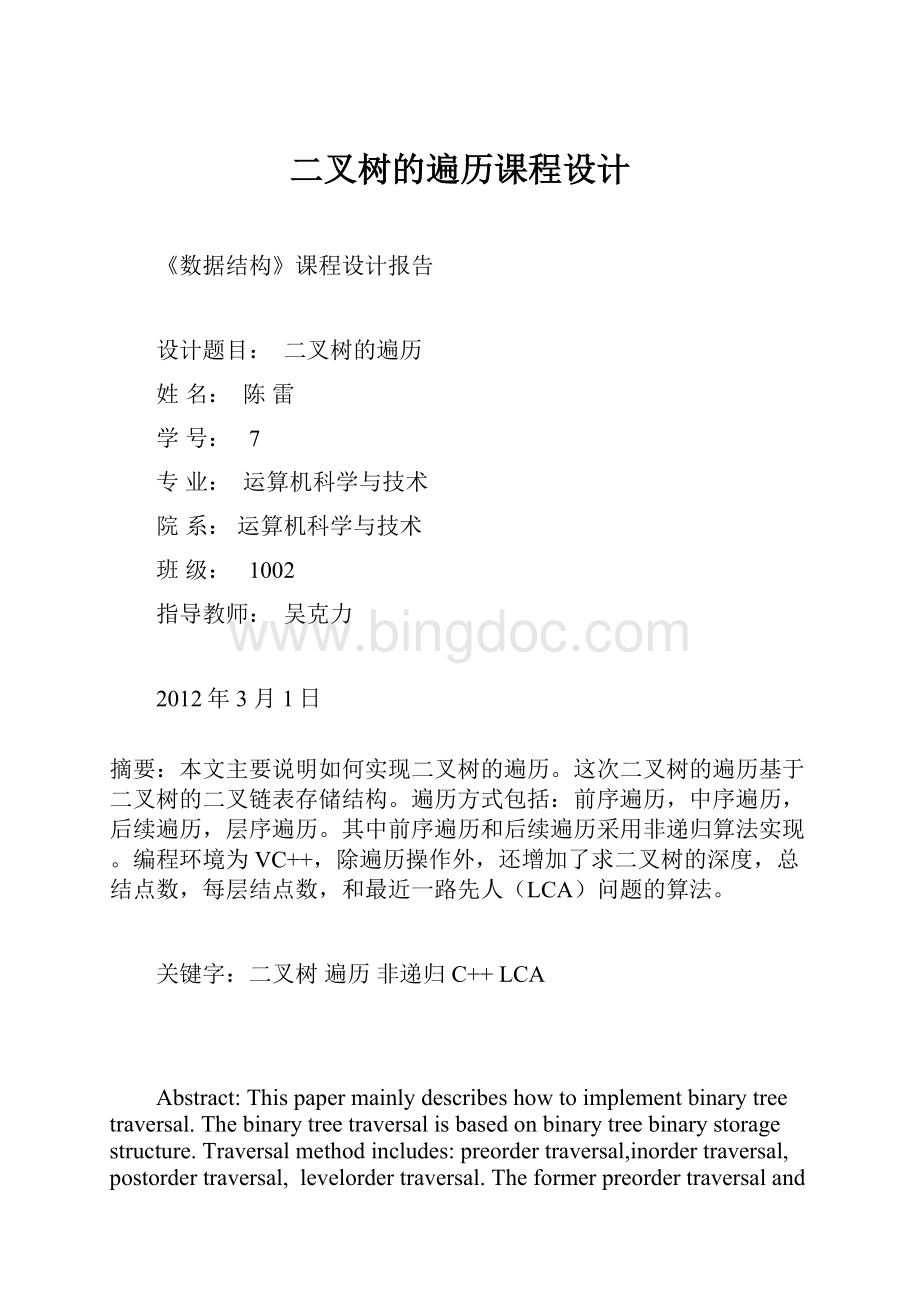二叉树的遍历课程设计.docx
《二叉树的遍历课程设计.docx》由会员分享,可在线阅读,更多相关《二叉树的遍历课程设计.docx(18页珍藏版)》请在冰点文库上搜索。

二叉树的遍历课程设计
《数据结构》课程设计报告
设计题目:
二叉树的遍历
姓名:
陈雷
学号:
7
专业:
运算机科学与技术
院系:
运算机科学与技术
班级:
1002
指导教师:
吴克力
2012年3月1日
摘要:
本文主要说明如何实现二叉树的遍历。
这次二叉树的遍历基于二叉树的二叉链表存储结构。
遍历方式包括:
前序遍历,中序遍历,后续遍历,层序遍历。
其中前序遍历和后续遍历采用非递归算法实现。
编程环境为VC++,除遍历操作外,还增加了求二叉树的深度,总结点数,每层结点数,和最近一路先人(LCA)问题的算法。
关键字:
二叉树遍历非递归C++LCA
Abstract:
Thispapermainlydescribeshowtoimplementbinarytreetraversal.Thebinarytreetraversalisbasedonbinarytreebinarystoragestructure.Traversalmethodincludes:
preordertraversal,inordertraversal,postordertraversal,levelordertraversal.Theformerpreordertraversalandpostorderuseofnon-recursivealgorithm.ProgrammingenvironmentisVC++,inadditiontotraversaloperation,alsoincreasedforsolvingthebinarytreedepth、summarypointsandeachlayerofnodes,aswellasthemostrecentcommonancestor(LCA)algorithm.
Keywords:
binarytreetraversalnon-recursiveC++LCA
一、问题描述
问题描述:
创建二叉树并遍历
大体要求:
1、别离运用非递归的方式完成对二叉树的先序和后序遍历
2、输出二叉树的高度
3、输出每一层的结点数
4、查找结点P和结点Q的最近一路先人
二、需求分析
1.本程序的功能包括二叉树的成立,二叉树的递归遍历,二叉树的非递归遍历,查询二叉树的深度,查询每层的结点数,查找两个结点的最近一路先人,二叉树的打印。
2.程序运行后显现提示信息,等候用户输入0—6以进入相应的操作功能。
3.用户输入数据完毕,程序将输出运行结果。
4.测试数据应为字符型数据。
三、概要设计
1.创建二叉树
输入数据不低于15个,用递归方式成立二叉树。
2.二叉树的非递归前序遍历示用意
图二叉树前序遍历示用意
3.二叉树的后序非递归遍历示用意
图二叉树后序遍历示用意
四、数据结构设计
1.二叉树结点数据类型概念为:
template
structBiNode
{
BiNode*rchild,*lchild;//指向左右孩子的指针
Tdata;//结点数据信息
};
2.二叉树数据类型概念为:
template
classBiTree
{
template
friendostream&operator<<(ostream&os,BiTree&bt);
public:
BiTree();//无参构造函数
BiTree(intm){};//有参空构造函数
BiTree(Tary[],intnum,Tnone);//有参构造函数
~BiTree();//析构函数
voidpreorder();//递归前序遍历
voidinorder();//递归中序遍历
voidpostorder();//递归后续遍历
voidlevelorder();//层序遍历
intcount();//计算二叉树的结点数
intdepth();//计算二叉树的深度
voiddisplay(ostream&os);//打印二叉树,有层次
voidLevelNum();//计算每一层结点数
voidPreOrder();//非递归前序遍历
voidPostOrder();//非递归后序遍历
voidcreat();//创建二叉树
TleastCommanAncestor(Tva,Tvb);//求树中任意两结点最近一路先人
protected:
//以下函数供上面函数挪用
//对应相同功能
voidcreat(BiNode*&root);//创建
voidrelease(BiNode*&root);//删除
BiNode*Build(Tary[],intnum,Tnone,intidx);//用数组创建二叉树
voidPreOrder(BiNode*root);//前序遍历
voidPostOrder(BiNode*root);//后续遍历
voidLevelNum(BiNode*root);//层序遍历
voidpreorder(BiNode*root);//递归前序遍历
voidinorder(BiNode*root);//递归中序遍历
voidpostorder(BiNode*root);//递归后续遍历
voidlevelorder(BiNode*root);//层序遍历
intcount(BiNode*root);//计算结点数
intdepth(BiNode*root);//计算深度
voiddisplay(ostream&os,BiNode*root,intdep);//打印
staticboolleastCommanAncestor(BiNode*root,Tva,Tvb,BiNode*&result,BiNode*parrent);//求最近一路先人
private:
BiNode*rootptr;
};
五、算法设计
一、创建二叉树
//实现外部递归挪用
voidBiTree:
:
creat()
{
creat(rootptr);
}
//类体内递归创建二叉树
template
voidBiTree:
:
creat(BiNode*&root)
{
Titem;
cin>>item;
if(item=='#')root=NULL;
else
{
root=newBiNode;
root->data=item;
creat(root->lchild);
creat(root->rchild);
}
}
2、非递归前序遍历
template
voidBiTree:
:
PreOrder()
{
PreOrder(rootptr);
}
template
voidBiTree:
:
PreOrder(BiNode*root)
{
stack*>s;
while(root!
=NULL||!
())
{
while(root)
{
cout<data;
(root);
root=root->lchild;
}
if(!
())
{
root=();
();
root=root->rchild;
}
}
}
3、非递归后序遍历
template
voidBiTree:
:
PostOrder()
{
PostOrder(rootptr);
}
template
voidBiTree:
:
PostOrder(BiNode*root)
{
stack*>s;//概念栈,节点类型为TreeNode
BiNode*p=root;
BiNode*pre=NULL;//pre表示最近一次访问的结点
while(p||!
())
{
//沿着左孩子方向走到最左下。
while(p)
{
(p);
p=p->lchild;
}
//getthetopelementofthestack
p=();
//若是p没有右孩子或其右孩子方才被访问过
if(p->rchild==NULL||p->rchild==pre)
{
//visitthiselementandthenpopit
cout<data;
();
pre=p;
p=NULL;
}
else
{
p=p->rchild;
}
}//endofwhile(p||()!
=0)
}
4、求二叉树的高度
template
intBiTree:
:
depth()
{
returndepth(rootptr);
}
template
intBiTree:
:
depth(BiNode*root)
{
intrdep,ldep;
if(root==NULL)
return0;
else
{
ldep=depth(root->lchild);
rdep=depth(root->rchild);
return(rdep>ldep?
rdep:
ldep)+1;
}
}
5、求二叉树每一层的结点数
template
voidBiTree:
:
LevelNum()
{
LevelNum(rootptr);
}
template
voidBiTree:
:
LevelNum(BiNode*root)
{
queue*>q;
intfront,rear,first,last,level;
front=rear=first=0;
last=level=1;
if(root)
{
(root);
rear++;
while(front{
root=();
();
front++;
if(root->lchild)
{
(root->lchild);
rear++;
}
if(root->rchild)
{
(root->rchild);
rear++;
}
if(front==last)
{
cout<<"第"<level++;
last=rear;
first=front;
}
}
}
}
6、求两节点最近一路先人
template
TBiTree:
:
leastCommanAncestor(Tn1,Tn2){
returnleastCommanAncestor(rootptr,n1,n2);
}
template
TBiTree:
:
leastCommanAncestor(BiNode*root,Tn1,Tn2)
{
if(root==NULL||root->data==n1||root->data==n2)
return-1;
if((root->rchild!
=NULL)&&
(root->rchild->data==n1||root->rchild->data==n2))
returnroot->data;
if((root->lchild!
=NULL)&&
(root->lchild->data==n1||root->lchild->data==n2))
returnroot->data;
if(root->data>n1&&root->datareturnroot->data;
if(root->data>n1&&root->data>n2)
returnleastCommanAncestor(root->lchild,n1,n2);
if(root->datadatareturnleastCommanAncestor(root->rchild,n1,n2);
}
6、算法流程图
六、程序测试与实现
一、函数之间的挪用关系
二、主程序
voidmain()
{
BiTreeTree
(1);
while
(1){
cout<<"\t\t欢迎利用本系统!
!
"<cout<<"\t\t########################################"<cout<<"\t\t##"<cout<<"\t\t#1--创建一颗二叉树并显示#"<cout<<"\t\t#2--遍历二叉树#"<cout<<"\t\t#3--查询二叉树的深度和结点数#"<cout<<"\t\t#4--查询每层结点数#"<cout<<"\t\t#5--查找两节点P和Q的最近一路先人#"<cout<<"\t\t#6--退出#"<cout<<"\t\t##"<cout<<"\t\t########################################"<cout<<"请输入你的选择:
";
intx;
cin>>x;
switch(x){
case1:
{
cout<<"请输入二叉树的前序遍历:
"<cout<<"(以#作为分支结尾,例如:
AB##C##)"<();
cout<cout<}break;
case2:
{
cout<cout<<"前序遍历为:
";
();
cout<cout<<"中序遍历为:
";
();
cout<cout<<"后序遍历为:
";
();
cout<cout<<"层序遍历为:
";
();
cout<cout<}break;
case3:
{
cout<<"树的深度为:
"<<()<cout<<"树的结点数:
"<<()<cout<}break;
case4:
{
();
}break;
case5:
{
charch1,ch2;
cout<<"请输入P数据信息:
";
cin>>ch1;
cout<<"请输入Q数据信息:
";
cin>>ch2;
cout<}break;
case6:
return;break;
default:
cout<<"请输入正确的选择!
!
!
"<}
}
}
3、测试数据
AB#CD###E#FGH##K###
4、测试结果
七、调试分析
创建二叉树:
依次输入二叉树前序遍历序列,构建相应的二叉树。
二叉树遍历:
递归算法、非递归算法测试,挪用相应函数进行测试,结果正确。
求二叉树深度和结点数:
创建一个二叉树,挪用相关函数,测试结果正确。
计算每层结点数:
挪用levelNum()函数,测试结果正确。
求最近一路先人:
挪用LCA()函数,测试结果正确。
八、碰到的问题及解决办法
调试时碰到诸多问题,其中最主要的问题是死循环问题,在非递归遍历时,容易进入死循环,通过查找资料、分步伐试最终找到循环结束条件,顺利解决各个难题。
九、心得体会
通过本次课程设计,我发觉,有关一个课题的所有知识不单单是在讲义上,多查阅一些资料能够更好的完成课题,这就需要一种能力,即自学能力。
本次课程设计还让我熟悉到自己的缺点。
本次选的课题是二叉树的遍历,因为本学期所学的就是二叉树等数据结构,所以以为比较适合。
刚开始以为会很简单,但到后来就出现一些难以解决的问题,就像老师请教,并查阅相关资料。
通过慢慢的调试,最终测试成功。
这次课程设计让我所学到的数据结构知识发挥的淋漓尽致,而且还拓展了我的知识面,使我加倍熟练的掌握各类方式。
总之,这次课程设计增强了我的自学能力,拓展了我的知识面,让我对数据结构加倍了解。
十、参考文献
《C++程序设计》(第二版)吴乃陵况迎辉
《数据结构C++版》王红梅